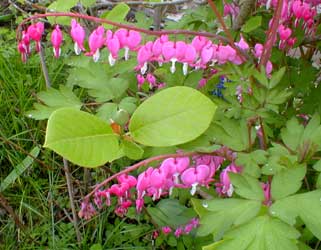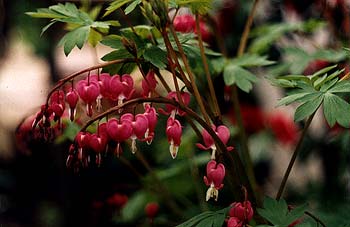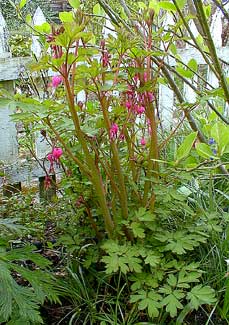
Old Fashioned Bleeding Hearts
"In this world
we walk on the roof of hell,
gazing at flowers."
-Kobayashi Issa
(1763-1827)
(1763-1827)
Dicentra spectabilis, the classic Bleeding Heart, is a hardy perennial with extravagant blooms that begin no later than late March, increasing in April, & lasting until the weather gets too hot for it & it grows summer-dormant.
A native of China, it is very happy in the Northwest & it sometimes seems that just everyone has them, as they should. We liked the standard form so much that we couldn't resist adding a couple of slightly fancy varieties, having added to our gardens D. spectabilis 'Alba,' which has large snow white hearts, & D. spectabilis 'Goldheart' which has bright golden-green leaves, which together dominate a shady area underneath a young but substantial Cedar of Lebanon.
Old Fashioned Bleeding Heart is extremely cold-hardy & does well in much chillier climates than ours, though wanting more sun in chillier zones. Temperate Puget Sound is just about as "hot" a location as it does really well in. Even here, if the soil never dries out, it will tolerate a lot of sun, but may die back entirely in summer rather than just grow dormant until Fall. It lasts longer into summer in ample shade, where it is ideal among ferns, hostas, & its close relative, Corydalis flexuosa. It needs continously moist soil except in winter when it vanishes & doesn't like its thick roots wet at that time.
 We initially planted the Bleeding Heart & the Corydalis together & the blue fish-shaped blooms of the latter looked tremendous in concert with the dangling heart-shaped blooms of the former. Both plants died to the ground in winter, but Corydalis regrows very strongly toward the end of winter & began to dominate the spot until April, when the Bleeding Heart finally emerges, grows to twice the height of the Corydalis, & owned the location by May.
We initially planted the Bleeding Heart & the Corydalis together & the blue fish-shaped blooms of the latter looked tremendous in concert with the dangling heart-shaped blooms of the former. Both plants died to the ground in winter, but Corydalis regrows very strongly toward the end of winter & began to dominate the spot until April, when the Bleeding Heart finally emerges, grows to twice the height of the Corydalis, & owned the location by May.Alas both these plants can get pretty crappy looking at the height of summer when at best they get scruffy from the heat & need shearing to induce a second burst for autumn. That the shade corridor had two dominating plants that weaken in summer was not good for that shade-garden's overall effect in summer. There was the added problem that the bleeding heart had gotten so enormous it was actually injuring smaller plants around it by completely blotting out even the small amounts of light required.
It was eventually necessary to transplant this giant bleeding heart. It had such an enormous thick root system it was inescapable that the roots got chopped all to hell despite taking out an enormous amount of soil with it. I feared it would be weakened for a while, but I had transplanted it in late autumn as it began its winter die-back, & it came back the following spring good as ever.
 The new location was underneath the deciduous Oyama Magnolia. The first photo above shows it in April (2004) with some big round Oyama leaves poking into the center of the picture. The second photo was snapped in its previous location, also in April (2001). The third photo shows it at the very start of April (2003), before it gets its long sweeping branches, but is already blooming on thick prehistoric-looking ferny stalks.
The new location was underneath the deciduous Oyama Magnolia. The first photo above shows it in April (2004) with some big round Oyama leaves poking into the center of the picture. The second photo was snapped in its previous location, also in April (2001). The third photo shows it at the very start of April (2003), before it gets its long sweeping branches, but is already blooming on thick prehistoric-looking ferny stalks.When the Bleeding Heart is at its peak of beauty, the Oyama is in full leaf protecting it from sun. But late winter, before the Bleeding Heart reemerges, & when the Oyama is still leafless, this is quite a sunny spot, where late-winter blooming snow crocuses flourish. As the early snow crocuses are finishing off, the bleeding heart is arriving with full force. So this has turned out to be a good marriage of species all round.
There are pint-sized versions of bleeding hearts. When we moved the giant one from the main shade corridor, we replaced it with ferns & D. eximia, the Eastern or Fringed Bleeding Heart. These are usually only one foot tall, so do not smother the smallest shade-plants in the vicinity. On the opposite side of the same path we have our local Northwest woodland native D. formosa, the Western Bleeding Heart.
These littler bleeding hearts do not have a summer dormancy, so the previous problem of the corydalis & the giant bleeding heart leaving too large a "weak" area at the height of summer is no longer a problem; & some evergreen ferns, wintergreen, & winter-flowering cyclamens keep the area exciting even at the height of winter when the corydalises & bleeding hearts are gone.
Bleeding Hearts is named quite obviously for the white & cherry-pink hanging hearts. It has had other interesting folk-names, including Lady's Locket, Lyre Flower, Tearing Hearts, Our-Lady-in-a-Boat, & Chinese Pants. In China they are called "Purse Peonies."
D. spectabilis first found its way to England in 1810, but died out before being widely gardened. The great plant explorer Robert Fortune introduced it again when the Royal Horitcultural Society sent him to China in 1846, when he collected it on the Island of Chusan. In the years that followed its second introduction to English cottage gardening, it made rapid inroads of popularity, so that by 1898, Shirley Hibberd in Familiar Garden Flowers called it "cheap, common, but very charming."
The flowers can be taken as cuttings for bouquets & last pretty well in the house.
These plants can be extremely long-lived & once they have a firm rooting require very little attention, though their soil should never entirely dry out unless in winter.